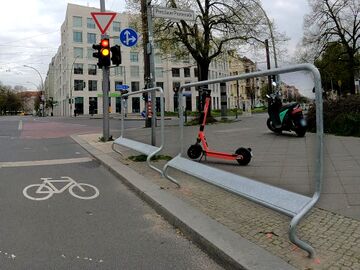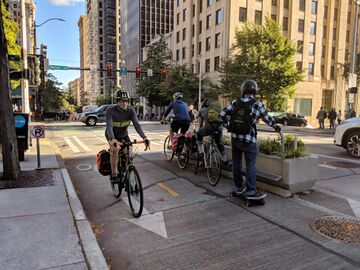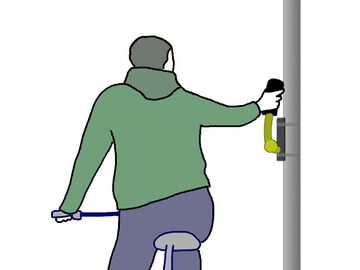Proposal:Highway=cyclist waiting aid
| The Feature Page for the approved proposal Cyclist footrests and handrails is located at Tag:highway=cyclist_waiting_aid |
| Cyclist footrests and handrails | |
|---|---|
| Proposal status: | Approved (active) |
| Proposed by: | Supaplex030 |
| Tagging: | highway=cyclist_waiting_aidfootrest=*handrest=*side=*
|
| Applies to: | |
| Definition: | Street furniture and devices for cyclists that are intended to make waiting at esp. traffic lights more comfortable. |
| Statistics: |
|
| Draft started: | 2021-05-05 |
| RFC start: | 2023-09-29 |
| Vote start: | 2023-11-07 |
| Vote end: | 2023-11-21 |
Proposal

For the past 15 years, street furniture or devices have been popping up in more and more cities that are intended to make it more comfortable for cyclists to wait esp. at traffic lights. Known as "cyclist footrests", "leaning rails" or "bike rests", they often include footrests and handrails. Also other types are existing, like single handgrips mounted directly on traffic light masts.
These "waiting aids" make it possible to rest one foot or lean on your hand while waiting. When continuing the ride, you can start cycling more quickly and safely. In a few cities they have been a common item of street furniture for many years (e.g. in some cities in Denmark and Sweden), in many other cities they are increasingly being installed as part of the efforts to promote cycling.
It is proposed to tag these waiting aids as nodes on the highway/cycleway line using highway=cyclist_waiting_aid. The subtags footrest=* and handrest=* can be added to differentiate between different types. The subtag side=* can be used to indicate the side of the way on which the waiting aid is located.
Tagging
Add a node with highway=cyclist_waiting_aid on the way (cycleway, path or other highway) next to the location of the waiting aid device. Connect the node to the way to make it easier to include the waiting aids in route planning and other applications. If there are several such devices in a row, place the node at the "first" waiting position (closest to the e.g. traffic lights/front of the queue).
If possible or necessary, add further details:
- Direction of travel: If the node is placed on a way that can be used by cyclists in both directions, indicate the
direction=*in which the waiting aid is available (forwardorbackward, depending on direction of way). - Specify components: Depending on the design of the waiting aid, add subtags for the existence of foot- or handrests (
yesorno): - Specifying side of use: Add the tag
side=*to indicate whether the waiting aid feature is located on theleftorrightside of the way, seen in the direction of travel of a waiting aid user (resp. on which side you can rest your leg or hand). In rare cases, alsobothmight be possible if there are waiting aid features on both sides of the way. - Additional useful tags: Other suitable tags can be added to specify physical properties (like
material=*,height=*,support=*) or to indicate the number of devices (count=*) or of cyclists that can wait there at the same time (capacity=*).
Avoid merging the waiting aid node with other nodes (like traffic signals or advanced stop lines). Usually, they are not in the same place when the waiting aid is mapped at the location of the first waiting position (see above). Some exemplary cases:
- At a traffic light, the waiting aid is usually located a few metres behind the stop line. Traffic lights and waiting aids can therefore be mapped with different nodes. For evaluations, they are clearly related via the connected highway line and their direction.
- Even in combination with an
cycleway=asl, the waiting aid should be mapped slightly behind the node for the ASL. - If a waiting aid is located directly on a pedestrian island (
highway=crossing+crossing:island=yes), a shared node can be avoided by mapping the pedestrian island separately (with surrounding road segments). For those who find this too complex, the waiting aid should be placed slightly next to the crossing node.
Examples
-
A common waiting aid combining a footrest and a handrail.
highway=cyclist_waiting_aidfootrest=yeshandrest=yesside=left -
Two waiting aids for cyclists on the right side of a cycleway.
highway=cyclist_waiting_aidfootrest=yeshandrest=yesside=rightmaterial=metalcount=2
(Usingcount=*to specify the number of devices instead ifcapacity=*in this case, as it is not necessarily clear how many cyclists can use a waiting aid device at a time.) -
Foot- and handrests on a planter (bi-directional cycleway).
highway=cyclist_waiting_aiddirection=backwardfootrest=yeshandrest=yesside=rightcount=3
(Assuming the way is directed like the arrow on the cycleway, the device is used in backward direction and is located on the left side of the OSM way, but it's located on the rightside=*for the users.)
Rationale
There have been several discussions in OSM about how to tag these increasingly appearing devices (see below), but so far without documented results. This proposal, based on past and current discussions, aims to fill this small gap.
Key: In the discussions on the proposal, it was controversial which key would be the best fit for waiting aid features. In the end, the proposal favours the key highway=* over other possibilities that might seem more appropriate at first glance (especially cycleway=* or amenity=*), as it leaves the minimum of misunderstandings and misinterpretations. cycleway=*, for example, usually attributes cycle lanes on the highway; it's use would be, like cycleway=asl, a further homonymous stretch of this understanding. amenity=* would be a rather untypical choice for a feature that is not mapped at its real location but at the point of its effect on the way. In the highway=* namespace, however, it is already common to map street-related features.
Value: It is proposed to use the value cyclist_waiting_aid, as this kind of device is unknown or makes little sense for other types of vehicles than bikes. In this way, these cyclist waiting aids can be clearly identified and distinguished from other street furniture or misleading uses (like regular railings intended as a barrier or devices that could be interpreted as "waiting aids" for pedestrians).
The value cyclist_waiting_aid is based on the intention and target group of the devices and includes all possible types and designs. The availability of different components such as footrests or handrails can be specified using subtags.
Subtags: The use of the two subtags footrest=* and handrest=* is intended to enable the simplest possible, but at the same time clear differentiation of various designs and types of waiting aid features. It follows a tagging practice that is already common in other contexts, for example with benches.
The attribute side=* (left, right or both) is proposed to be used to specify the side on which the waiting aid feature is located. It refers to the side in the direction of travel of a waiting aid user on which a leg or hand can be rested. This variant offers a very simple and intuitive way of specifying the side of the feature without having to use directional side suffixes (like footrest:left=yes), which in cases of bidirectional ways (esp. with a waiting aid feature in backward direction) often lead to misinterpretations, because the side of the suffix differs from the side of the actual use.
External discussions
The question of how this type of street furniture should be tagged has popped up on different channels from time to time over the last few years. Known discussions are:
- In February 2019, the question came up in the German forum about how to tag such devices, but without result.
- Another discussion startet in September 2020 on the Tagging Mailing List (“Biker’s rests”), with a follow-up in January 2021 (“Street furniture tagging”), but without a concrete tagging recommendation.
- After the first footrests were installed in Berlin at the beginning of 2021, there was a further discussion in the Berlin Verkehrswende Group (a local group of the Berlin OSM community focussed on the topic of transportation, traffic and mobility) and the tagging
amenity=cyclist_leaning_railwas suggested on yet another follow-up on Tagging in May (“Cyclist Leaning Rails”). - At the beginning of 2023, this question appeared in a Reddit channel, resulting in a second proposal, suggesting to use
cycleway=footrest. - In September 2023, the question was discussed in the German Telegram Channel, followed by a restart of the old German discussion thread from 2019.
- Finally, to merge previous discussions and debate solutions in a larger audience, a thread and poll in the community forum was started that was the base for a rework of this proposal.
- A short thread on Mastodon confirmed that an alternative way to tag the side of the waiting aid was needed.
Comments
Please comment on the discussion page.
Voting
Voting on this proposal has been closed.
It was approved with 26 votes for, 0 votes against and 0 abstentions.
 I approve this proposal. The proposal has already been sufficiently commented on and refined and, in my view, provides a good basis for tagging. --Mcliquid (talk) 16:06, 7 November 2023 (UTC)
I approve this proposal. The proposal has already been sufficiently commented on and refined and, in my view, provides a good basis for tagging. --Mcliquid (talk) 16:06, 7 November 2023 (UTC) I approve this proposal. Good rationale and sound explanation of what's supposed to be tagged. --Kai M. Poppe (talk) 16:08, 7 November 2023 (UTC)
I approve this proposal. Good rationale and sound explanation of what's supposed to be tagged. --Kai M. Poppe (talk) 16:08, 7 November 2023 (UTC) I approve this proposal. What Mcliquid said. Well done! --Nadjita (talk) 16:19, 7 November 2023 (UTC)
I approve this proposal. What Mcliquid said. Well done! --Nadjita (talk) 16:19, 7 November 2023 (UTC) I approve this proposal. --Rskedgell (talk) 16:21, 7 November 2023 (UTC)
I approve this proposal. --Rskedgell (talk) 16:21, 7 November 2023 (UTC) I approve this proposal. Good job --Map HeRo (talk) 18:51, 7 November 2023 (UTC)
I approve this proposal. Good job --Map HeRo (talk) 18:51, 7 November 2023 (UTC) I approve this proposal. --Nw520 (talk) 19:18, 7 November 2023 (UTC)
I approve this proposal. --Nw520 (talk) 19:18, 7 November 2023 (UTC) I approve this proposal. -- Something B (talk) 21:44, 7 November 2023 (UTC)
I approve this proposal. -- Something B (talk) 21:44, 7 November 2023 (UTC) I approve this proposal. --NieWnen (talk) 22:14, 7 November 2023 (UTC)
I approve this proposal. --NieWnen (talk) 22:14, 7 November 2023 (UTC) I approve this proposal. --CaldeiraG (talk) 16:08, 8 November 2023 (UTC)
I approve this proposal. --CaldeiraG (talk) 16:08, 8 November 2023 (UTC) I approve this proposal. --Kylenz 19:15, 8 November 2023 (UTC)
I approve this proposal. --Kylenz 19:15, 8 November 2023 (UTC) I approve this proposal. --B-unicycling (talk) 23:50, 8 November 2023 (UTC)
I approve this proposal. --B-unicycling (talk) 23:50, 8 November 2023 (UTC) I approve this proposal. – Gymate (talk) 12:11, 9 November 2023 (UTC)
I approve this proposal. – Gymate (talk) 12:11, 9 November 2023 (UTC) I approve this proposal. --Adiatmad (talk) 03:53, 16 November 2023 (UTC)
I approve this proposal. --Adiatmad (talk) 03:53, 16 November 2023 (UTC) I approve this proposal. Can't believe this is missing. --HellMap (talk) 10:48, 18 November 2023 (UTC)
I approve this proposal. Can't believe this is missing. --HellMap (talk) 10:48, 18 November 2023 (UTC) I approve this proposal. --AmOosm (talk) 11:03, 18 November 2023 (UTC)
I approve this proposal. --AmOosm (talk) 11:03, 18 November 2023 (UTC) I approve this proposal. --快乐的老鼠宝宝 (talk) 11:57, 19 November 2023 (UTC)
I approve this proposal. --快乐的老鼠宝宝 (talk) 11:57, 19 November 2023 (UTC)
- Although I agree with this proposal, I still have questions:
(1) Why not use way instead of node. (2) If a kerb is mapped, should you continue to draw it on the highway (or maybe I misunderstood it, it is a standalone point), or do you think it would be more accurate to move it to the kerb? --快乐的老鼠宝宝 (talk) 12:01, 19 November 2023 (UTC)
 I approve this proposal. --OSMRogerWilco (talk) 13:27, 19 November 2023 (UTC)
I approve this proposal. --OSMRogerWilco (talk) 13:27, 19 November 2023 (UTC) I approve this proposal. --Spughetti (talk) 13:30, 19 November 2023 (UTC)
I approve this proposal. --Spughetti (talk) 13:30, 19 November 2023 (UTC) I approve this proposal. --Tordans (talk) 18:04, 19 November 2023 (UTC)
I approve this proposal. --Tordans (talk) 18:04, 19 November 2023 (UTC) I approve this proposal. --Gendy54 (talk) 19:39, 19 November 2023 (UTC)
I approve this proposal. --Gendy54 (talk) 19:39, 19 November 2023 (UTC) I approve this proposal. --Mtmail (talk) 19:53, 19 November 2023 (UTC)
I approve this proposal. --Mtmail (talk) 19:53, 19 November 2023 (UTC) I approve this proposal. --Makiwolf (talk) 22:51, 19 November 2023 (UTC)
I approve this proposal. --Makiwolf (talk) 22:51, 19 November 2023 (UTC) I approve this proposal. Make waiting great again. --scai (talk) 12:21, 20 November 2023 (UTC)
I approve this proposal. Make waiting great again. --scai (talk) 12:21, 20 November 2023 (UTC) I approve this proposal. --Rouelibre (talk) 13:37, 20 November 2023 (UTC)
I approve this proposal. --Rouelibre (talk) 13:37, 20 November 2023 (UTC) I approve this proposal. --EneaSuper (talk) 08:19, 21 November 2023 (UTC)
I approve this proposal. --EneaSuper (talk) 08:19, 21 November 2023 (UTC) I approve this proposal. --Aseidel (talk) 08:59, 21 November 2023 (UTC)
I approve this proposal. --Aseidel (talk) 08:59, 21 November 2023 (UTC)



